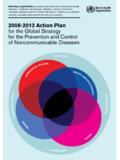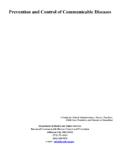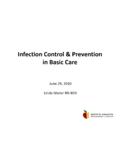Transcription of 11. Control of communicable diseases and …
1 168. 11. Control of communicable diseases and prevention of epidemics The importance of communicable diseases in emergencies and disasters The five most common causes of death in emergencies and disasters are diarrhoea, acute respiratory infection, measles, malnutrition and, in endemic zones, malaria. All except malnutrition are communicable diseases directly related to environmental health con- ditions, and even malnutrition is greatly exacerbated by communicable disease . Disaster-affected people are particularly vulnerable to communicable diseases when the disaster and its immediate consequences reduce resistance to disease because of mal- nutrition, stress, fatigue, etc. and when post-disaster living conditions are unsanitary. The Control of communicable diseases depends on a healthy environment (clean water, adequate sanitation, vector Control , shelter), immunization, and health workers trained in early diagnosis and treatment.
2 Thanks to effective environmental health measures, epidemics following disasters are no longer common. Exceptions are the epi- demics occurring in chronic emergencies triggered by drought and civil strife, such as those that occurred in Africa in the 1980s and 1990s, and the epidemics of communi- cable diseases that have swept refugee camps in Africa and other parts of the world. Func- tioning disease surveillance systems and intact environmental health services are crucial in protecting public health and in responding to these outbreaks when they occur in times of disaster. The conditions leading to an epidemic are caused mostly by secondary effects and not by the primary hazard, except in the case of flooding, which can cause an increase in waterborne and vector-borne diseases (see Box ). Other hazards may leave stand- ing water or pollute, or interrupt drinking-water supplies. High winds, coastal storms, mud slides and even earthquakes can all result in standing water, especially where a cascade of physical effects occurs.
3 For instance, in the Andes it is not uncommon for a volcanic eruption to melt ice and snow, creating floods, mud flows and rock falls. Earth- quakes can trigger landslides that block rivers, causing flooding. In all these cases, excess standing water can promote the breeding of insect disease vectors, or contaminate water supplies with waste or sewage. Both natural disasters and armed conflict may result in the breakage of water mains or the interruption of electricity supplies required to pump water. Sewer pipes and sewage treatment works may also be broken or rendered inoperable. Besides waterborne and vector-borne disease , there may also be major epidemics of highly contagious diseases those spread by personal contact. These are most commonly the result of crowding survivors living in crowded temporary accommodation without adequate ventilation or adequate facilities for personal hygiene and laundry. The length of time that people spend in temporary settlements is an important deter- minant of the risk of disease transmission.
4 The prolonged mass settlement of refugees in temporary shelters with only minimal provision for essential personal hygiene is typical of a situation that may cause epidemic outbreaks of infectious diseases (see Box ). Camps established to provide food relief during famine are a special case, as large numbers of people who are already weak and possibly ill are likely to remain in such camps for a long time. 11: Control OF communicable diseases AND prevention OF EPIDEMICS. 169. Box Flooding in the Czech Republic1. Eastern areas of the Czech Republic were severely flooded in the summer of 1997. A total of 438 towns and villages were affected, and 2151 homes were destroyed. More than 200 000. people were left without electricity and 30 000 without gas. About 3500 wells and other water sources were contaminated and wastewater-treatment plants were rendered inoperable. The Centre of Microbiology of the Czech National Institute of Public Health took immediate action, in collaboration with the regional hygiene stations.
5 All reports of outbreaks of typhoid fever, sal- monellosis, shigellosis, acute diarrhoea, viral hepatitis A, tularaemia, invasive meningococcal disease , toxoplasmosis, leptospirosis and Lyme disease were evaluated, and a special hepati- tis A vaccination programme was launched among 3 15-year-olds in selected areas. Postdis- aster analysis showed that leptospirosis had increased threefold, but that there had been no demonstrable flooding effects in the other diseases targeted. No viral hepatitis A was reported from the populations vaccinated. Recommended follow-up measures included monitoring and controlling rodents. 1. Source: B. Kriz, unpublished data, 1998. Box Monitoring mortality among refugees in eastern Zaire1,2. During the emergency phase of a relief operation, death rates should be expressed as deaths/10 000 per day to allow for the detection of sudden changes. In general, health workers should be concerned when crude mortality rates (CMRs) in a displaced population exceed 1/10.
6 000 per day, or when under-five mortality rates exceed 2/10 000 per day. In eastern Zaire in July 1994, the CMR among one million Rwandan refugees ranged from to 000 per day, among the highest ever recorded. Between 6 and 10% of the refugee population died during the month after arrival in Zaire. This high mortality rate was almost entirely due to an epidemic of diarrhoeal diseases and inadequate water supply. By the third week of the refugee influx, relief efforts began to have a significant impact. Routine measures, such as measles immunization, vitamin A supplements, standard disease - treatment protocols and community outreach programmes, were established in each camp, and the water-distribution system began to provide an average of 5 10 litres per person per day. 1. Source: International Federation of Red Cross and Red Crescent Societies (1997b). 2. Now the Democratic Republic of the Congo A comprehensive overview of the public health consequences of various forms of dis- asters may be found in Noji (1997).
7 Table presents an overview of the disease prob- lems most often encountered following disasters. Such problems are more likely to occur where predisaster conditions, such as those in many densely populated mega-cities, are unsanitary. Steps taken in advance to reduce poverty, increase the level of awareness and organization, and extend normal health and sanitary services will provide additional pro- tection for the community if disaster strikes. Measures for controlling communicable diseases and epidemics Preparedness and prevention Preparedness measures taken before a disaster can greatly increase the ability to Control communicable diseases and prevent epidemics. Such measures include: training health and outreach staff in the identification and management of specific diseases considered ENVIRONMENTAL HEALTH IN EMERGENCIES AND DISASTERS. 170. Table diseases affecting displaced populations in disasters Environmental risk disease Symptoms factors Health hazards Acute upper All symptoms of the common cold, Crowding, poor hygiene Influenza and pneumonia may respiratory tract fever and heavy coughing.
8 Chest pain cause severe complications, infections and pain between shoulder blades in especially in groups at risk pneumonia. Diarrhoea Watery stools at least three times a Contaminated drinking- Dehydration, especially in day, with or without blood or slime. water or food, or poor children, shown by dark May be accompanied by fever, sanitation colouration of urine, dry nausea or vomiting. tongue or leathery skin Measles A disease of early childhood, Crowding, poor hygiene Severe constitutional characterized by fever and catarrhal symptoms, high case fatality symptoms, followed by maculopapular rate rash in the mouth. Malaria Painful muscles and joints, high fever Breeding of Anopheles disease may rapidly become with chills, headache, possibly mosquitoes in stagnant fatal, unless medical care is diarrhoea and vomiting. water bodies provided within the first 48 hours Meningococcal Infected persons may show no Crowding Often fatal if untreated at an meningitis symptoms for a considerable time.
9 Early stage; neurological When an epidemic is in progress, problems in survivors headache, fever and general malaise will suggest the diagnosis, which must be confirmed by lumbar puncture. Shigella Diarrhoea with blood in the stools, Contaminated drinking- Case fatality rate may be dysentery fever, vomiting and abdominal cramps. water or food, or poor high sanitation, poor hygiene Viral hepatitis A Nausea, slight fever, pale-coloured Poor hygiene Long-term disabling effects stools, dark-coloured urine, jaundiced eye whites and skin after several days. Louse-borne Prolonged fever, headache, body Unhygienic conditions May be fatal without typhus pains. leading to lice treatment infestations Typhoid fever Starts off like malaria, sometimes with As for diarrhoea Without appropriate medical diarrhoea, prolonged fever, care, may lead to fatal occasionally with delirium. complications in a few weeks Cholera Modest fever, severe, but liquid As for diarrhoea As for diarrhoea diarrhoea (rice water stools), abdominal spasms, vomiting, rapid weight loss and dehydration.
10 Dengue and High fever, headaches, pain in Breeding of Aedes Dengue usually runs a mild dengue muscles and joints, red spots on skin. mosquitoes in natural course. DHF, however, is haemorrhagic or artificial containers, often accompanied by heavy fever (DHF) filled with water haemorrhages, which may be fatal Diphtheria Inflamed and painful throat, coughing. Crowding, poor hygiene A secretion is deposited in the respiratory tract, which can lead to asphyxiation 11: Control OF communicable diseases AND prevention OF EPIDEMICS. 171. Table (continued). Environmental risk disease Symptoms factors Health hazards Tetanus Muscle spasms, starting in the jaws Poor hygiene, injury Fatal and extending to the rest of the body over several days Rabies Fatigue, headache, disorientation, Bite from infected Fatal if untreated paralysis, hyperactivity animal host Relapsing fever Acute high fever at intervals Unhygienic conditions Often fatal in untreated (louse-borne or leading to lice or tick persons, depending on tick-borne) infestations immunity levels Heat stress Elevated body temperatures, nausea, Excessive temperatures Risk of coma vomiting, headache to be a threat; creating local stocks of supplies and equipment for diagnosis, treatment and environmental health measures in case of disease outbreaks; strengthening health- surveillance systems and practicing protocols for managing information on certain dis- eases.












